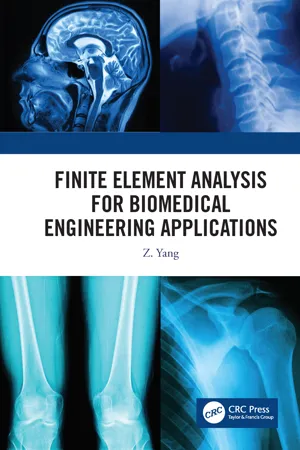
Finite Element Analysis for Biomedical Engineering Applications
Z. Yang
- 302 Seiten
- English
- ePUB (handyfreundlich)
- Über iOS und Android verfügbar
Finite Element Analysis for Biomedical Engineering Applications
Z. Yang
Über dieses Buch
Finite element analysis has been widely applied to study biomedical problems. This book aims to simulate some common medical problems using finite element advanced technologies, which establish a base for medical researchers to conduct further investigations.
This book consists of four main parts: (1) bone, (2) soft tissues, (3) joints, and (4) implants. Each part starts with the structure and function of the biology and then follows the corresponding finite element advanced features, such as anisotropic nonlinear material, multidimensional interpolation, XFEM, fiber enhancement, UserHyper, porous media, wear, and crack growth fatigue analysis. The final section presents some specific biomedical problems, such as abdominal aortic aneurysm, intervertebral disc, head impact, knee contact, and SMA cardiovascular stent. All modeling files are attached in the appendixes of the book.
This book will be helpful to graduate students and researchers in the biomedical field who engage in simulations of biomedical problems. The book also provides all readers with a better understanding of current advanced finite element technologies.
-
- Details finite element modeling of bone, soft tissues, joints, and implants
-
- Presents advanced finite element technologies, such as fiber enhancement, porous media, wear, and crack growth fatigue analysis
-
- Discusses specific biomedical problems, such as abdominal aortic aneurysm, intervertebral disc, head impact, knee contact, and SMA cardiovascular stent
-
- Explains principles for modeling biology
-
- Provides various descriptive modeling files
Häufig gestellte Fragen
Information
Inhaltsverzeichnis
- Cover
- Half Title
- Title Page
- Copyright Page
- Contents
- Preface
- About the Author
- Chapter 1: Introduction
- Part I: Bone
- Part II: Soft Tissues
- Part III: Joints
- Part IV: Simulation of Implants
- Part V: Retrospective
- Appendix 1: Input File of the Multidimensional Interpolation in Section 3.2.2
- Appendix 2: Input File of the Anisotropic Femur Model in Section 4.2
- Appendix 3: Input File of the XFEM Crack-Growth Model in Section 5.2
- Appendix 4: Input File of the Abdominal Aortic Aneurysm Model in Section 7.2
- Appendix 5: Input File of the Periodontal Ligament Creep Model in Section 8.2
- Appendix 6: Input File of the Intervertebral Disc Model with Fiber Enhancement in Section 9.1.2
- Appendix 7: Input File of the Intervertebral Disc Model with Mesh Independent Fiber Enhancement in Section 9.2.2
- Appendix 8: Input File of the Anterior Cruciate Ligament Model in Section 9.3.2
- Appendix 9: Input File of Subroutine UserHyper in Section 10.2
- Appendix 10: Input File of the Head Impact Model in Section 11.2
- Appendix 11: Input File of the Intervertebral Disc Model in Section 11.3
- Appendix 12: Input File of the Knee Contact Model in Section 13.2
- Appendix 13: Input File of the 2D Axisymmetrical Poroelastic Knee Model in Section 13.3
- Appendix 14: Input File of the Discrete Element Model of Knee Joint in Chapter 14
- Appendix 15: Input File of the Material Definition of the Cancellous Bone in Chapter 15
- Appendix 16: Input File of the Stent Implantation Model in Chapter 16
- Appendix 17: Input File of the Wear Model of Hip Replacement in Chapter 17
- Appendix 18: Input File of the Mini Dental Implant Crack-Growth Model in Chapter 18
- Index